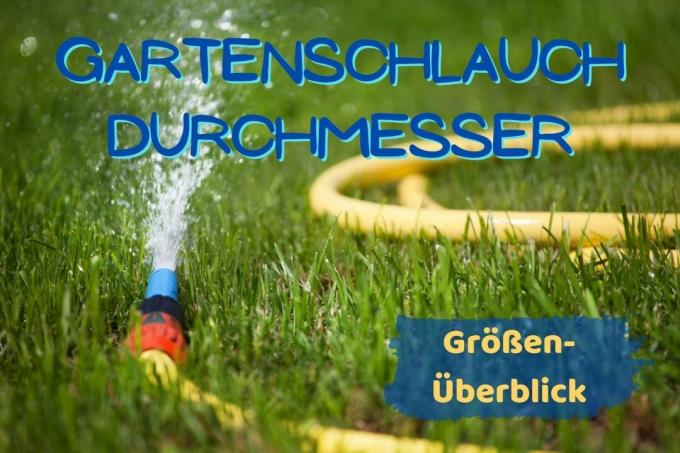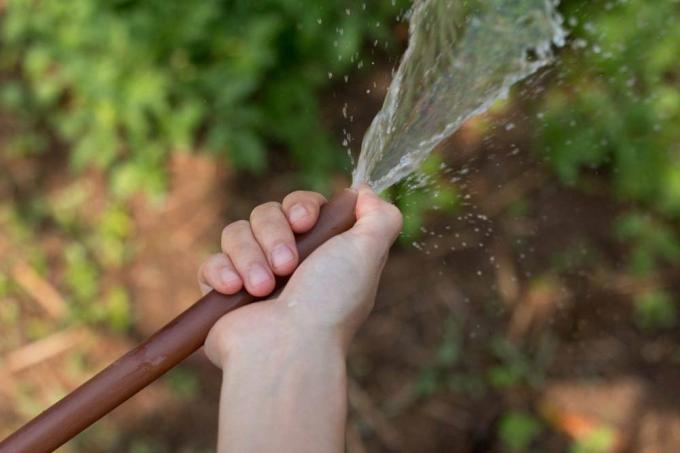
table of contents
- Garden hose: standard diameter
- other sizes
- frequently asked Questions
When choosing a garden hose, the right diameter is one of the most important criteria. This article gives you an overview of the garden hose diameters that you can use for private use.
In a nutshell
- Garden hoses are selected based on inside diameter
- Inside diameter is given in inches or mm
- ranges from 6 to 50 mm
- The diameter must correspond to the outside diameter of the fittings
Garden hose: standard diameter
When looking for garden hoses, there are certain standard sizes that you will come across the most often. There are three sizes that you will come across most often:
- 1/2 inch: 12.7 mm (DN 12)
- 5/8 inch: 15.9 mm (DN 15)
- 3/4 inch: 19 mm (DN 19)
You are probably wondering what the names are all about. The inner diameter of the garden hose is always given in inches. For this reason, it is important that you know the diameter in millimeters for the respective inch. This is the only way you can be sure that you have selected the right model. Not every manufacturer specifies the hose diameter on the packaging. You can also use the DN information as a guide, which is standardized in accordance with DIN EN ISO 6708.

Note: The faucet and pipe diameter are specified in either inches or millimeters, depending on the model and manufacturer. Check the dimensions for the hose beforehand before you decide on one.
other sizes
In addition to the standards already mentioned, there are other sizes in which garden hoses are available. Garden hoses are manufactured in diameters from 6.3 to 50.8 millimeters, which are suitable for the majority of households in Germany and Europe. The following list gives you an overview of the other hose diameters:
- 1/4 inch: 6.3 mm (DN 6)
- 1 inch: 25.4 mm (DN 25)
- 1 1/4 inch: 31.7 mm (DN 32)
- 1 1/2 inches: 38.1 mm (DN 38)
- 2 inches: 50.8 mm (DN 50)
Note: Garden hoses with larger diameters are better for stationary use, such as supplying a Irrigation system suitable. Thinner hoses, on the other hand, are ideal for watering by hand, hard-to-reach areas and filling watering cans.
frequently asked Questions
You have to select the hose depending on the outside diameter of the fitting or hose sleeve. This means that if you want to connect the hose to a faucet with an outside diameter of 19 millimeters, you will need a 3/4 hose. Other values are not important for compatibility. The garden hose should never be chosen too big or too small for it to function optimally.
An adapter is necessary if the hose does not have the appropriate inner diameter for the outer diameter of the fitting. The hose can be attached to the fittings via the adapter without a complete replacement, which makes it possible to use it at low cost. The adapter is attached to the fitting and the hose can then be easily attached.
Choosing the wrong diameter can lead to a variety of problems. For example, if you select a hose with an inside diameter that is too large, there will be a loss of pressure. As a result, the water no longer comes out of the hose with the usual force. On the other hand, if the hose is too small, the pressure is too high and permanent damage is possible.
If the garden hoses are too short, you can connect them to one another using hose sleeves. This way you get a much longer connection that is possible with any hose. Just be sure to use the larger inner diameter tubing first and finish with the smallest one. This allows the pressure to be stabilized better.
